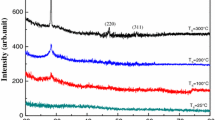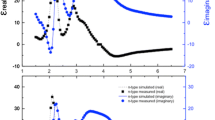Abstract
Device quality undoped hydrogenated microcrystalline silicon has been prepared by plasma enhanced chemical vapor deposition under different conditions. The dependence of physical, chemical, structural, and electrical properties on the deposition conditions has been investigated. Conductive (conductivity above 10−3Ω−1 cm−1) and resistive (conductivity around 10−9Ω−1cm−1) layers having approximately the same grain size, at a given substrate temperature, have been deposited between 200 and 500°C at two different hydrogen dilutions. Independently of the hydrogen dilution, the average grain sized is dependent on the deposition temperature and the film thickness; and a maximum average grain size of about 40 nm has been achieved for a thick film deposited at 500°C. The density of paramagnetic defects also increases with increasing deposition temperature, which indicates that more dangling bond defects are introduced as the total area of the grain boundaries increases. The etch rate decreases with increasing deposition temperature, and for the films deposited at 250 and 500°C the etch rate has been measured to be 6.6 and 2.7 nm/min, respectively. Thin film transistors incorporating a microcrystalline channel have been fabricated and evaluated. The best device had the following properties: field effect mobility, threshold voltage, and on/off current ratio of about 0.8 cm2/V sec, below 5 V, and around 106, respectively.
Similar content being viewed by others
References
A. Matsuda, J. Non Cryst. Solids, 59&60, 767 (1983).
S. Veprek, Z. Iqbal, R.O. Kuhne, P. Capezzuto, F.A. Sarott and J.K. Gimzewski, J. Phys. C: Solid State Phys., 16, 6241 (1983).
Y. Mishima, S. Miyazaki, M. Hirose and Y. Osaka, Philos. Mag. B, 46, 1 (1982).
T.D. Moustakas, D.A. Weitz, E.B. Prestridge and R. Friedman, Mat. Res. Soc. Symp. Proc., 38, 401 (1985).
W.E. Spear, G. Willeke and P.G. LeComber, Physica, 117B & 118B, 908 (1983).
N. Shibata, K. Fukuda, H. Ohtoshi, J. Hanna, S. Oda and I. Shimizu, Jpn. J. Appl. Phys., 26, L10 (1987).
Z. Iqbal and S. Veprek, J. Phys. C: Solid State Phys., 15, 377 (1982).
J. Kanicki, E. Hasan, J. Griffith, T. Takamori and J.C. Tsang (this volume).
N. Lustig and J. Kanicki, J. Appl. Phys., 65, 3951 (1989).
The ESR measurements were done by Dr. D. Jousse (personal communication of the unpublished data).
S. Miyazaki, Y. Osaka and M. Hirose, Solar Energy Mat., 11, 85 (1984).
Author information
Authors and Affiliations
Rights and permissions
About this article
Cite this article
Kanicki, J., Hasan, E., Kotecki, D.F. et al. Properties and Application of Undoped Hydrogenated Microcrystalline Silicon Thin Films. MRS Online Proceedings Library 149, 173–179 (1989). https://doi.org/10.1557/PROC-149-173
Published:
Issue Date:
DOI: https://doi.org/10.1557/PROC-149-173




